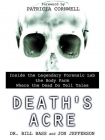Death's Acre: Inside The Legendary Forensic Lab The Body Farm Bill Bass (howl and other poems TXT) 📖

- Author: Bill Bass
Book online «Death's Acre: Inside The Legendary Forensic Lab The Body Farm Bill Bass (howl and other poems TXT) 📖». Author Bill Bass
A year or two before, one of my University of Kansas Ph.D. students, Bob Gilbert, had requested pubic bones from medical examiners around the country. Bob was researching skeletal differences between males and females—specifically, the gradual changes that occur in the female pubic symphysis, the joint where the two pubic bones, arching forward from the hipbones, meet at the front of the pelvis. In young adults the surface of the pubic symphysis is rugged, ridged, and grooved; by the mid-thirties the bone is denser and its texture smoother; after age fifty, the face of the joint itself begins to erode. Bob’s Ph.D. dissertation aimed to chart those changes in the female pubic symphysis in detail, so that anthropologists could estimate age more precisely. To do that, he needed pubic bones, and lots of them.
Some of the medical examiners he contacted were shocked by his request and refused. But Dr. Jerry Francisco, the chief medical examiner in Tennessee, was intrigued by the research and recognized its potential contribution to forensic science. He sent Bob a batch of pubic bones, and he became a good friend of mine, trading stories with me at forensic meetings.
When I told Jerry I was moving to Tennessee, he asked if I’d be interested in joining his staff as state forensic anthropologist. It wouldn’t pay much—a flat fee of $150 per case—but the work promised to be fascinating. Immensely flattered, I said yes at once. Not long after that, I also received a fancy badge as a special consultant to the Tennessee Bureau of Investigation. Eventually, I realized that if I hadn’t been working these cases as a state official, I could have charged a hefty hourly consulting rate. Sadly, by the time I figured that out, I’d grown far too fond of the fancy title and the shiny badge to give them up just for something as common as money. One particularly complex forensic case in the 1990s consumed hundreds of hours of my time; in that case my $150 fee translated into less than a dollar an hour. But hey, I also got the privilege of taking a lot of abuse on the witness stand too. Defense attorneys love to bring up the Colonel Shy case, even if it has no connection with their client’s case, to sow seeds of doubt in the minds of jurors. (“Isn’t it true, Dr. Bass, that your estimate of time since death in that case was off by nearly 113 years?!”)
I was still settling into my first semester at the University of Tennessee when the calls and cases and bodies began coming in. It didn’t take long to notice a difference between Kansas bodies and Tennessee bodies. More often than not, the Kansas corpses tended to be clean, sun-bleached skeletons, like something you’d see in a Hollywood western. The typical Tennessee body, I noticed very quickly, was more often a rotting, maggot-laden mess. In fact, of the first ten sets of remains brought to me for examination by Tennessee law enforcement officers after I arrived in Knoxville, half were swarming with maggots.
The difference was a function of geography and demographics: Kansas is twice the size of Tennessee—about 82,000 square miles, compared to Tennessee’s approximately 42,000—but has barely half as many people. Statistically speaking, then, the odds of stumbling across a fresh body in Kansas are only one-fourth the odds of tripping over a corpse in the Volunteer State. (Actually, the difference is even larger than that, because Tennesseans tend to die younger, thanks to a homicide rate that’s twice as high—a problem for someone in another field to figure out.) Since there are far more bodies in Tennessee lying around waiting to be found—often by hunters tramping around in the woods—it stands to reason they’re likely to be found more quickly than that handful of Kansas bodies quietly skeletonizing out there on the vast, lonesome prairie. Hence, dead Tennesseans are likely to be a lot messier and smellier.
Still, there was justice to be served. And for a forensic anthropologist—particularly a TBI-badge-toting, official state forensic anthropologist—squeamishness was not an option. I had let it be known that I was available to help identify bodies or determine cause of death. Therefore every case was welcome and so was every body. But some were more welcome than others—to me, and to the other faculty and staff who shared our quarters beneath the football stadium. It was the janitor who finally snapped.
A FISHERMAN HAD found a “floater”—a floating corpse—in the Emory River, about fifty miles from Knoxville, and a Roane County deputy sheriff brought me the body for identification. The dead man was still wearing most of his clothes; unfortunately, he wasn’t still wearing his head. That would make it difficult, if not impossible, to identify him positively. “We need to find the head,” I told the deputy. It might well be at the bottom of the Emory far from where the fisherman had found the body, but there was also a chance somebody had found the skull lying on the riverbank somewhere and maybe even picked it up.
The body arrived on a Wednesday. On Thursday the Roane County News, the area’s weekly paper, ran a front-page story on the discovery of the body and the importance of the missing skull. The article asked anyone who had seen or acquired a skull to bring it to the sheriff’s department. Over the next few days two skulls arrived, which deputies duly delivered to me.
The first one, which came in on Friday, was dry





Comments (0)